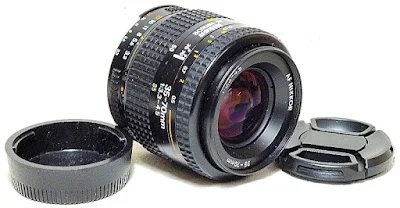These lenses were among the initial batch of Nikon autofocus lenses designed for the AF Nikon F501 / N2020 SLR camera in 1986.
The MK II version is identified by its broader manual focus ring and was assembled mainly at the Nikon production site in Thailand. The 8-element in 7 groups close focus lens is similar in optical composition to the Zoom-Nikkor 35-70mm f/3.3-4.5 Ai-S, a manual focus iteration that was bundled as a kit lens for the Nikon F301 and AF F501 35mm SLR film cameras, as well as other consumer-grade AF Nikons SLRs that followed the two.
The all-plastic zoom has a metal mount, and at 260 grams, which is only slightly heavier than its manual focus iteration, is one of the most compact AF Nikkor zoom lenses on the market in the early years of AF photography. The AF version comes with a built-in CPU, continues with the metal mount. It has a rather frail look and comes with a low price point to attract first-time SLR buyers to the Nikon 35mm photographic system.
The lens did not enjoy much of a rapport on the reviews, ending up with both brickbats as well as the occasional accolade. Nevertheless, it is still a lens worth looking at, taking a few images with, and working with a zoom range, you can learn the basics of creative photography. On the APS-C Nikon D200, the lens is equivalent to a 52.5-105mm standard telephoto on a 35mm full-frame camera, a good option for having a standard normal 50mm lens, and a short telephoto for candids, portraits, and general photography.
This review is part of the 'CCD Resurgence' series, with images captured on the 2005 Nikon D200, a very well-built and robust professional-grade digital SLR camera (much like the Nikon D2X) with a 10.3MP CCD sensor. While the interest in CCD photography is building up, why not grab the opportunity and enhance it with test shots and early images of equally vintage lenses?
Early Images
The lens I tested was still quick and nimble, even with the older camera, and comparatively noisy with its screw-drive mechanism, which is not really a bother for vintage Nikon users. Overall, the camera is still a good bet to have mounted on your camera, and with the overall compact dimension of the camera and lens, it should be fun to use and carry around, especially when you are traveling.
Shots across the zoom range.
A pair of close-ups from the garden.
And a walk around the kids' playpen in the community garden.
The CCD Sensor and Vintage Lenses
While CCD sensor cameras and vintage lenses are low-cost additions to your camera bag, CCD sensors are recognized for their low noise and high sensitivity images, and vintage lenses, as in this case, the AF-Nikkor 35-70mm f/3.3~4.5 can be found on online auction markets for as low as US$5.
They are also a lot of fun to work with, especially with image characters that may not be reproduced with the technologically advanced lenses of today.























No comments:
Post a Comment